1993 CHEVROLET CAVALIER check engine
[x] Cancel search: check enginePage 156 of 308
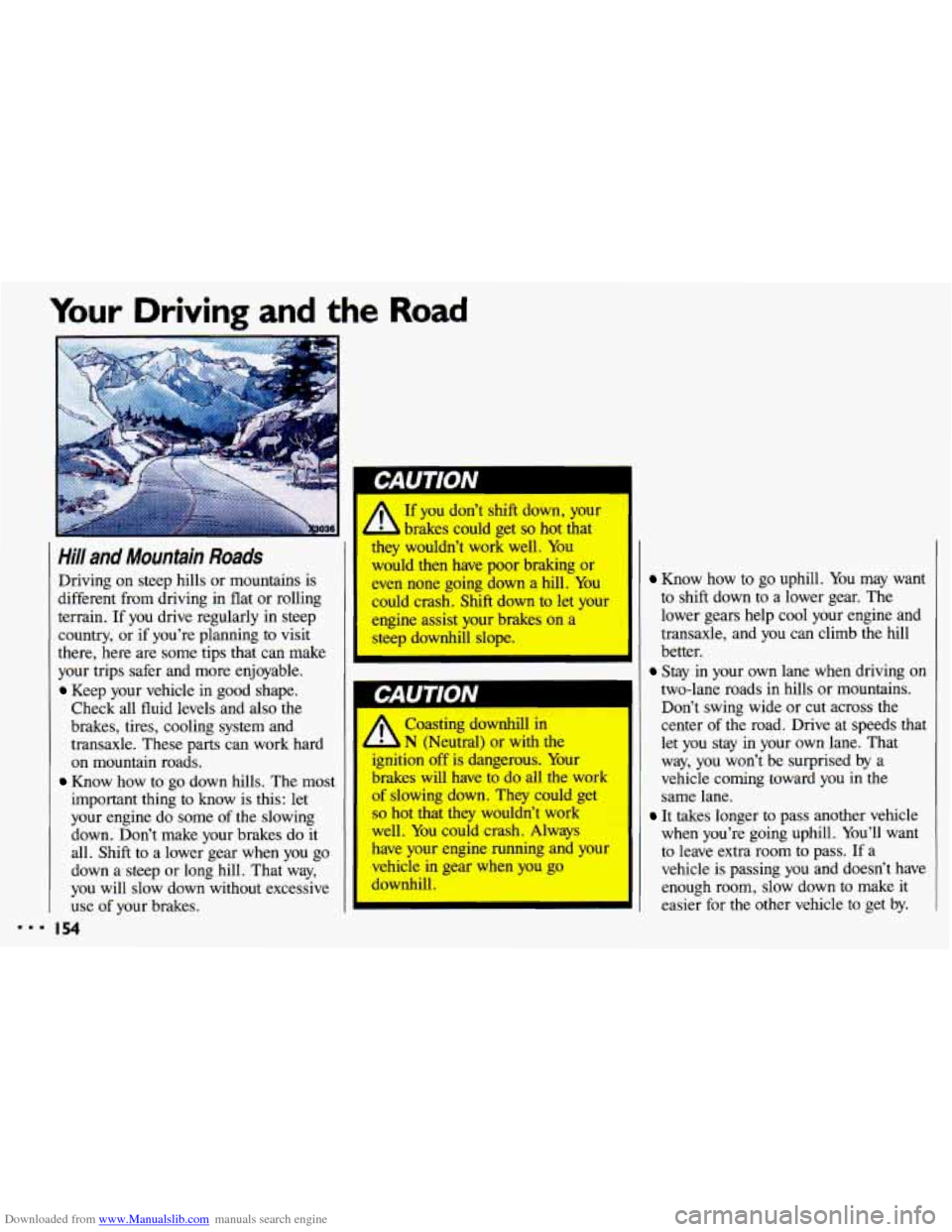
Downloaded from www.Manualslib.com manuals search engine Your Driving and the Road
mmm ‘I
”- .
Hill and Mountain Roads
Driving on steep hills or mountains is
different from driving in flat or rolling
terrain. If you drive regularly in steep
country, or if you’re planning to visit
there, here are some tips that can make
your trips safer and more enjoyable.
Keep your vehicle in good shape.
Check all fluid levels and
also the
brakes, tires, cooling system and
transaxle. These parts can work hard
on mountain roads.
Know how to go down hills. The most
important thing to know is this: let
your engine do some
of the slowing
down. Don’t make your brakes do it
all. Shift to a lower gear when you go
down a steep or long hill. That way,
you will slow down without excessive use of your brakes.
I 54
r If you don’t shift down, your
brakes could get
so hot that
they wouldn’t work well. You
would then have poor braking or
even none going down a hill. You
could crash. Shift down to let your
engine assist your brakes on a
steep downhill slope.
Coasting downhill in
N (Neutral) or with the
ignition
off is dangerous. Your
brakes will have
to do all the work
of slowing down. They could get
so hot that they wouldn’t work
well.
You could crash. Always
have
your engine running and your
vehicle in gear when you go
downhill.
Know how to go uphill. You may want
to shift down to a lower gear. The
lower gears help cool your engine and
transaxle, and
you can climb the hill
better.
Stay in your own lane when driving on
two-lane roads in hills or mountains.
Don’t swing wide or cut across the
center of the road. Drive at speeds that
let you stay in your own lane. That
way, you won’t be surprised by a
vehicle coming toward you in the
same lane.
It takes longer to pass another vehicle
when you’re going uphill. You’ll want
to leave extra room to pass.
If a
vehicle is passing you and doesn’t have
enough room, slow down to make it
~ easier for the other vehicle to get by.
Page 161 of 308
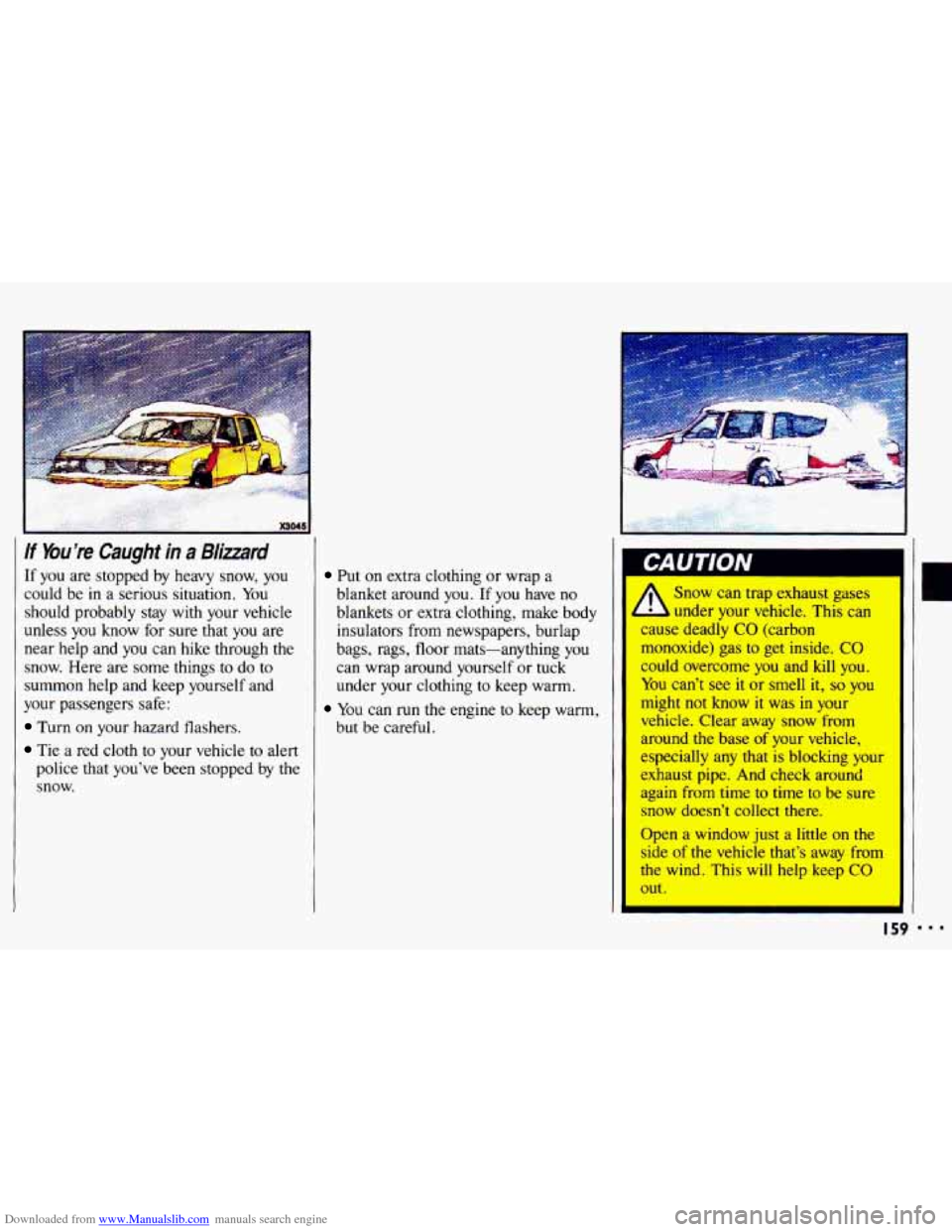
Downloaded from www.Manualslib.com manuals search engine If You’re Caught in a Blizzard
If you are stopped by heavy snow, you
could be
in a serious situation. You
should probably
stay with your vehicle
unless you know for sure that
you are
near help and you can
hike through the
snow. Here are some things to do to
summon help and keep yourself and
your passengers safe:
Turn on your hazard flashers.
Tie a red cloth to your vehicle to alert
police that you’ve been stopped by
the
snow.
Put on extra clothing or wrap a
blanket around you. If you have
no
blankets or extra clothing, make body
insulators from newspapers, burlap
bags, rags, floor mats-anything
you
can wrap around yourself or tuck
under your clothing to keep warm.
You can run the engine to keep warm,
but be careful.
I
A a
-C L Snow can trap exhaust gases
L under your vehicle. This can
cause deadly
CO (carbon
monoxide) gas to get inside.
CO
could overcome you and kill you.
You can’t see
it or smell it, so you
might not know
it was in your
vehicle. Clear away snow from
around the base of your vehicle,
especially any that is bloclng your
exhaust pipe. And check around
again from time to time to be sure
snow doesn’t collect there.
Open a window just a
little on the
side of the vehicle that’s away from
the wind. This
will help keep CO
out.
Page 167 of 308
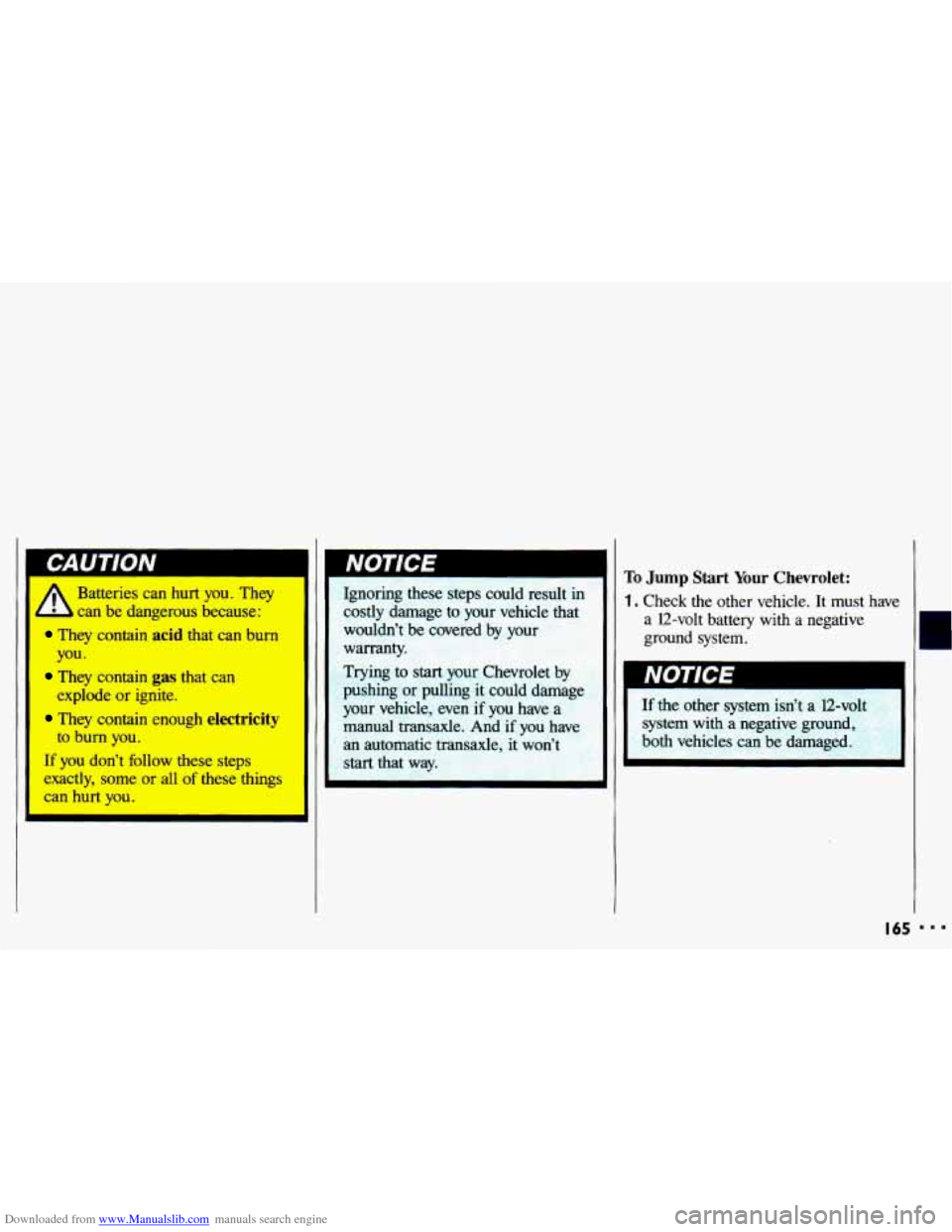
Downloaded from www.Manualslib.com manuals search engine Batteries can hurt you. They
- b can be dangerous because:
They contain acid that can burn
They contain gas that can
They contain enough electricity
If you don’t follow these steps
exactly, some or
all of these things
can hurt you.
you.
explode
or ignite.
to burn you. Ignoring these
steps could result in
costly damage to your vehicle that
wouldn’t be wered by your
warranty.
Trying
to st your Chevrolet by
pushing
or pulling it could damage
your vehicle, even if you have
a
manual transaxle. And if you ha---
an automatic transaxle, it won’t
start that way.
To Jump Start Your Chevrolet:
1. Check the other vehicle. It must have
a 12-volt battery with a negative
ground system.
If the other system isn’t a 12-volt
system with a negative ground,
both vehicles can be damaged.
NOTICE I
I65 ...
Page 169 of 308
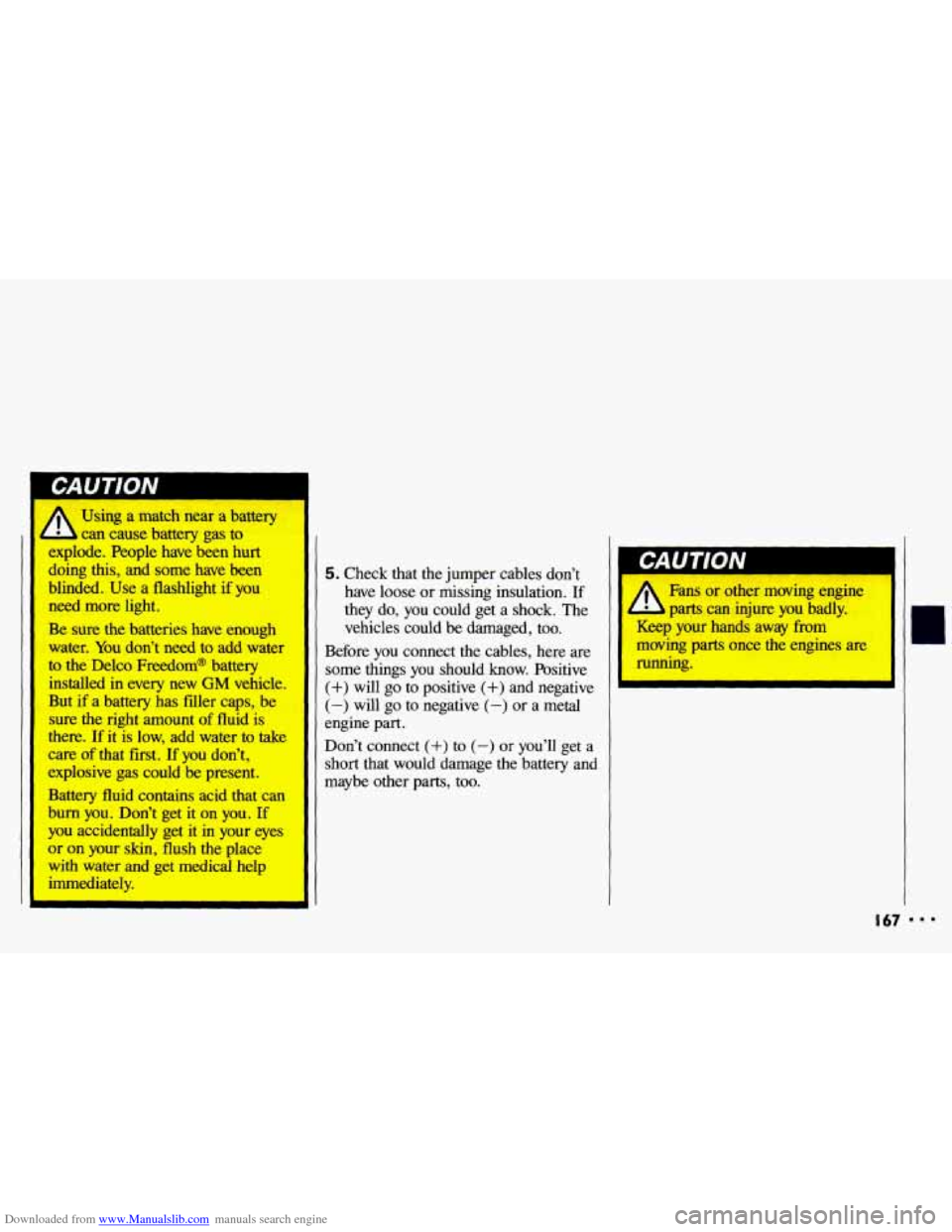
Downloaded from www.Manualslib.com manuals search engine Using a match near a battery
can cause battery gas to
explode. People have been hurt
doing
this, and some have been
blinded. Use a flashlight if you
need
more light.
Be
sure the batteries have enough
water. You
don’t need to add water
to the Delco Freedom@ battery
installed in every new GM vehicle.
But if a battery has filler caps, be
sure the right amount
of fluid is
there. If it is low, add water to take
care of that first. If you don’t,
explosive gas could be present.
Battery fluid contains acid that can
burn you. Don’t get it on you.
If
you accidentally get it in your eyes
or on your skin, flush the place
with water and get medical help
immediately.
5. Check that the jumper cables don’t
have
loose or missing insulation. If
they do, you could get a shock. The
vehicles could be damaged, too.
Before you connect the cables, here are
some things you should know. Positive
(+) will go to positive (+) and negative
(-) will go to negative (-) or a metal
engine part.
Don’t connect
(+) to (-) or you’ll get a
short that would damage the battery and
maybe other parts, too.
4
Fans or other moving engine
parts can injure you badly.
Keep your hands away
from
moving parts once the engines are
running.
167
Page 179 of 308
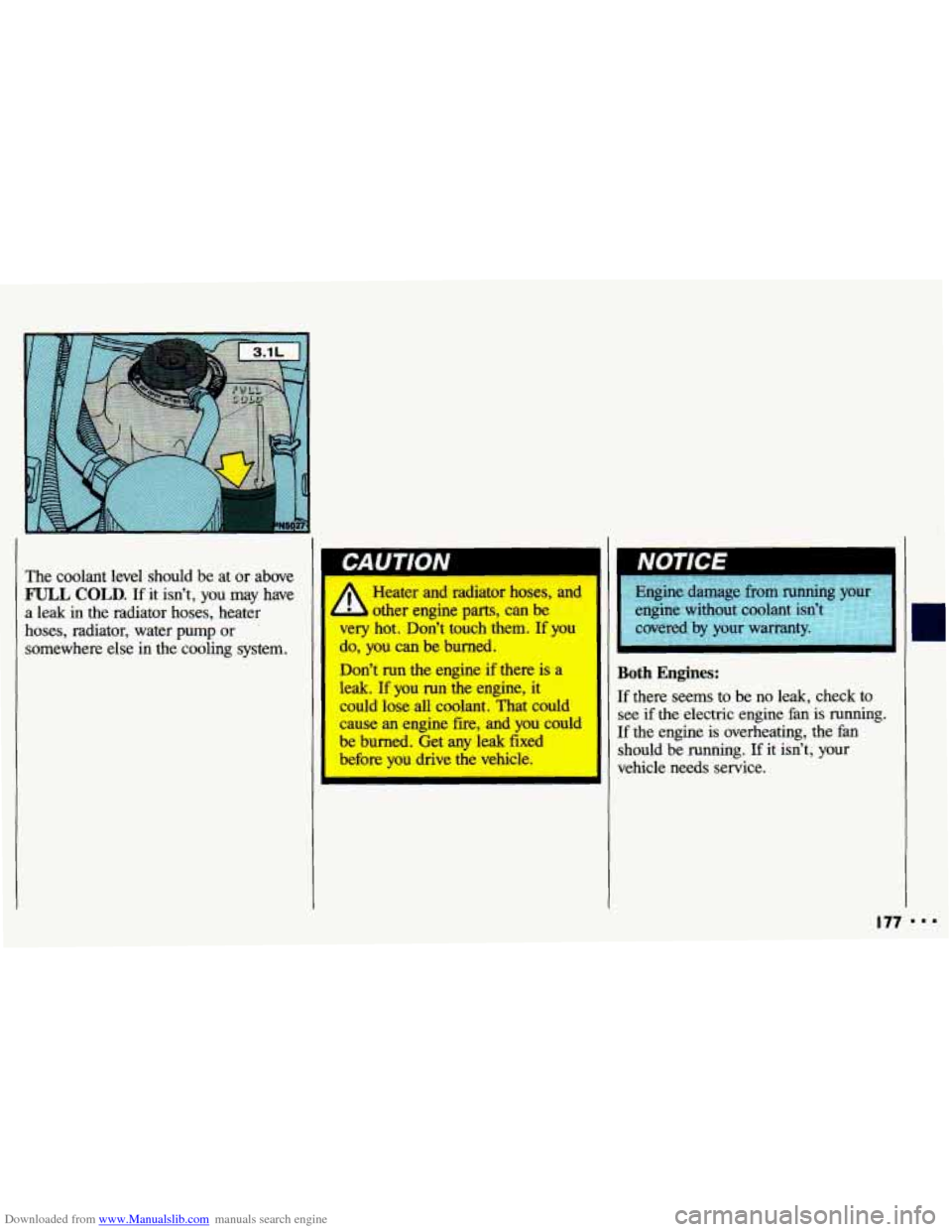
Downloaded from www.Manualslib.com manuals search engine The coolant level should be at or above
FULL COLD. If it isn’t, you may have
a leak
in the radiator hoses, heater
hoses, radiator, water pump
or ’
somewhere else in the cooling system.
, Heater and radiator hoses, and
- b other engine parts, can be
very hot. Don’t touch them.
If you
do,
you can be burned.
Don’t run the engine
if there is a
leak.
If you run the engine, it
could lose all coolant. That could
cause
an engine fire, and you could
be burned. Get any leak
fixed
before you drive the vehicle.
Both Engines:
If there seems to be no leak, check to
see
if the electric engine fan is running.
If the engine is overheating, the fan
should be running. If it isn’t, your
vehicle needs service.
I77 I..
Page 193 of 308
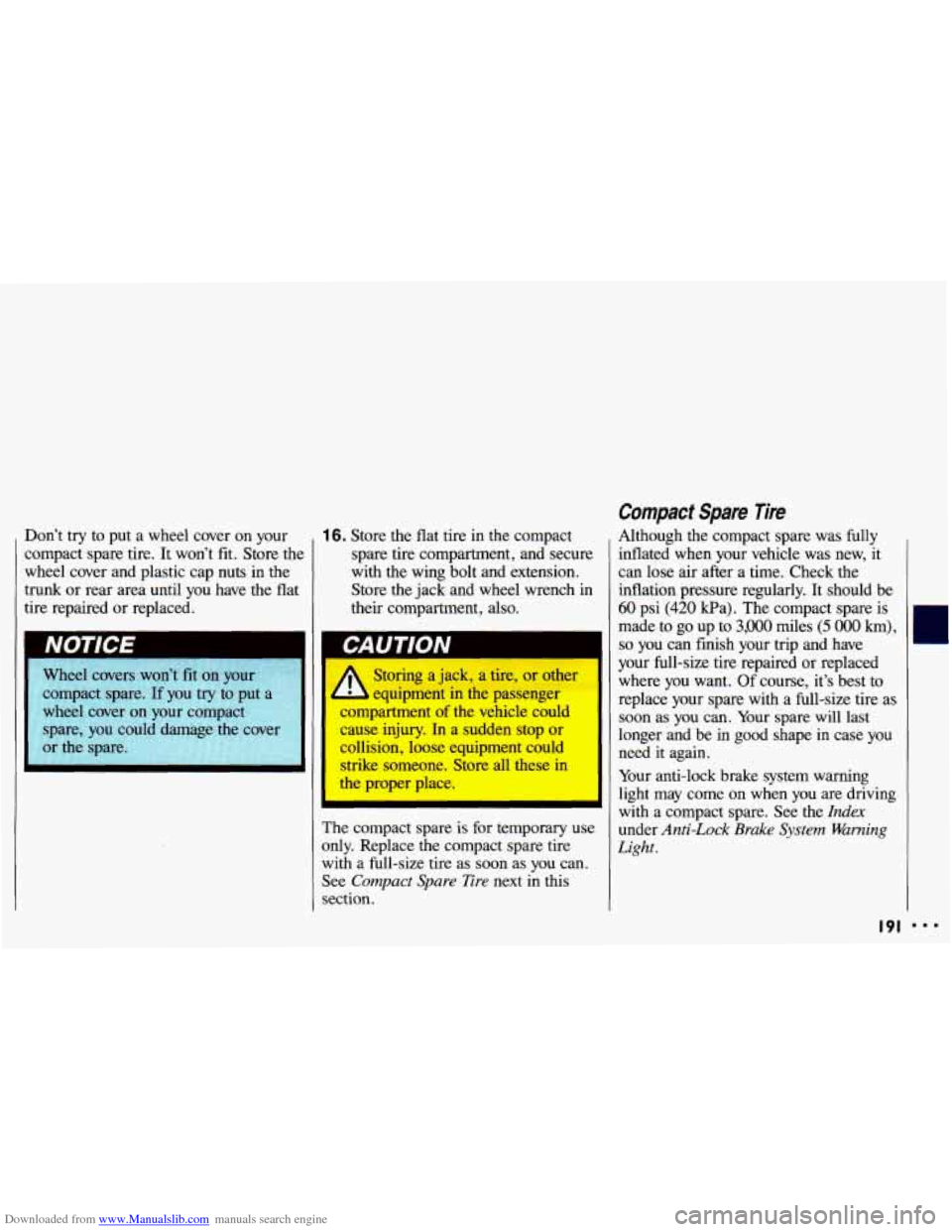
Downloaded from www.Manualslib.com manuals search engine Don’t try to put a wheel cover on your
compact spare tire.
It won’t fit. Store the
wheel cover and plastic cap nuts in the
trunk or rear area until you have the flat
tire repaired or replaced.
16. Store the flat tire in the compact
spare tire compartment, and secure
with the wing bolt and extension.
Store the jack and wheel wrench in
their compartment, also.
MU I IVN 1
Storing a jack, a tire, or other
:quipment in the passenger
compartment
of the vehicle could
cause injury. In a sudden stop
or
collision, loose equipment could
strike someone. Store all these in
the proper place.
The compact spare is for temporary use
only. Replace the compact spare tire
with a full-size tire as soon as you can.
See
Compact Spare Tire next in this
section.
Compact Spare Tire
Although the compact spare was fully
inflated when your vehicle was new, it
can lose air after a time. Check the
inflation pressure regularly.
It should be
60 psi (420 Wa). The compact spare is
made to go up to
3,000 miles (5 000 km),
so you can finish your trip and have
your full-size tire repaired or replaced
where you want.
Of course, it’s best to
replace
your spare with a full-size tire as
soon as you can. Your spare will last
longer and be in good shape in case you
need it again.
Your anti-lock brake system warning
light may come on when you are driving
with a compact spare. See the
Index
under Anti-Lock Brake System Warning
Light.
191
Page 197 of 308
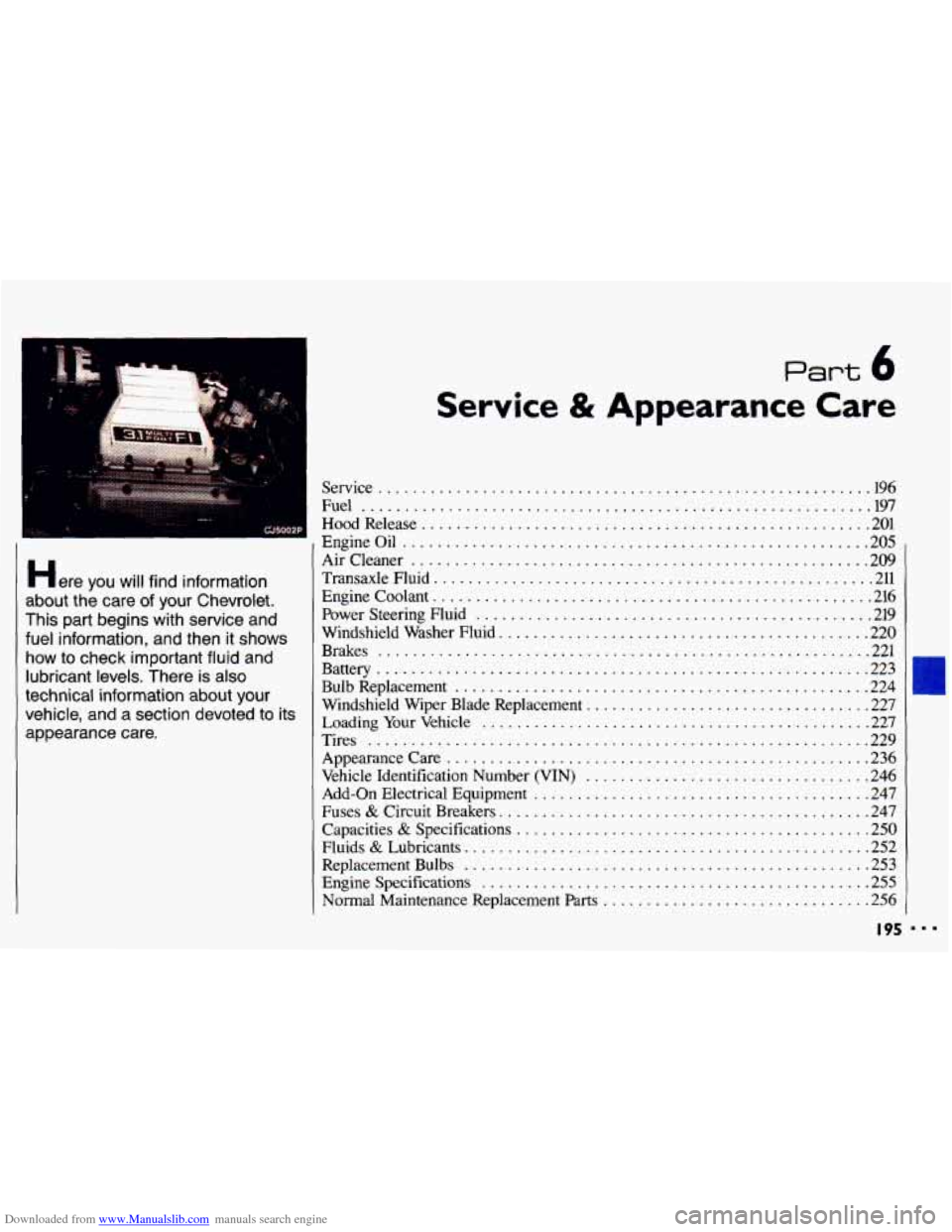
Downloaded from www.Manualslib.com manuals search engine i
.....
.................................. ...................
........ ... . &5
..... ..... .... .. --
' . I .. ~
Here you wit1 find information
about the care
of your Chevrolet .
This part begins with service and
fuel information. and then
it shows
how to check important fluid and
lubricant levels
. There is also
technical information about your
vehicle. and
a section devoted to its
appearance care
.
Part 6
Service & Appearance Care
Service ......................................................... 196
Fuel ........................................................... 197
HoodRelease
.................................................... 201
EngineOil
...................................................... 205
Aircleaner
..................................................... 209
Transaxle Fluid
................................................... 211
Engine Coolant
................................................... 216
Power Steering Fluid
.............................................. 219
Windshield Washer Fluid
........................................... 220
Brakes
......................................................... 221
Battery
......................................................... 223
BulbReplacement
................................................ 224
Windshield Wiper Blade Replacement
................................. 227
Loading
Your Vehicle ............................................. 227
Vehicle Identification Number (VIN)
................................. 246
Add-on Electrical Equipment
....................................... 247
Fuses
& Circuit Breakers ........................................... 247
Capacities & Specifications ......................................... 250
Fluids & Lubricants ............................................... 252
Replacement Bulbs
............................................... 253
Engine Specifications
............................................. 255
Normal Maintenance Replacement
Parts ............................... 256
Tires .......................................................... 229
Appearancecare
................................................. 236
I95
Page 201 of 308

Downloaded from www.Manualslib.com manuals search engine In addition, some gasoline suppliers are
now producing reformulated gasolines.
These gasolines are specially designed
to reduce vehicle emissions. General
Motors recommends that you use
reformulated gasoline. By doing
so, you
can help clean the air, especially in
those parts of the country that have high
ozone levels.
You should ask your service station
operators if their gasolines contain
detergents and oxygenates, and if they
have been reformulated to reduce
vehicle emissions.
X
Fuels in Foreign Countries
If you plan on driving in another
country outside the
U.S. or Canada,
unleaded fuel may be hard to find.
Do not use leaded gasoline. If you use
even one tankful, your emission controls
won’t work well or at all. With
continuous use, spark plugs can get
fouled, the exhaust system can corrode,
and your engine oil can deteriorate
quickly. Your vehicle’s oxygen sensor
will be damaged. All of that means
costly repairs that wouldn’t be covered
by your warranty.
To check on fuel availability, ask an auto
club, or contact a major
oil company
that does business in the country where
you’ll be driving.
You can also write us at the following
address for advice. Just tell us where
you’re going and give your Vehicle Identification Number (VIN).
General Motors of Canada Ltd.
International Export
- Sales
P.O. Box 828
Oshawa, Ontario LEX 7Ni, Canada
I99